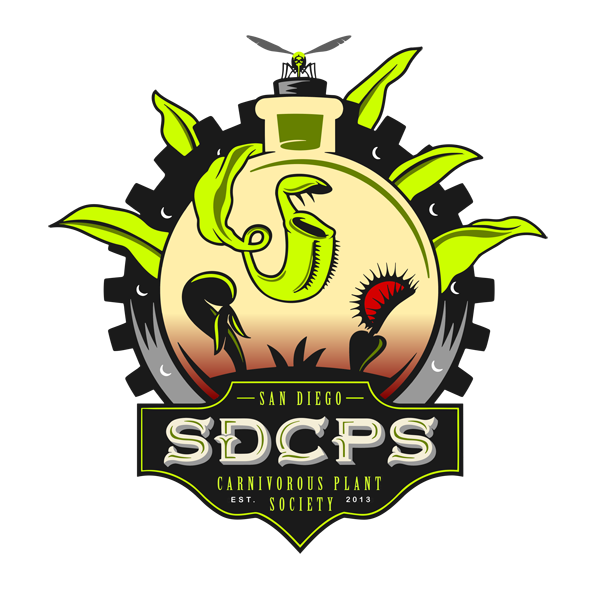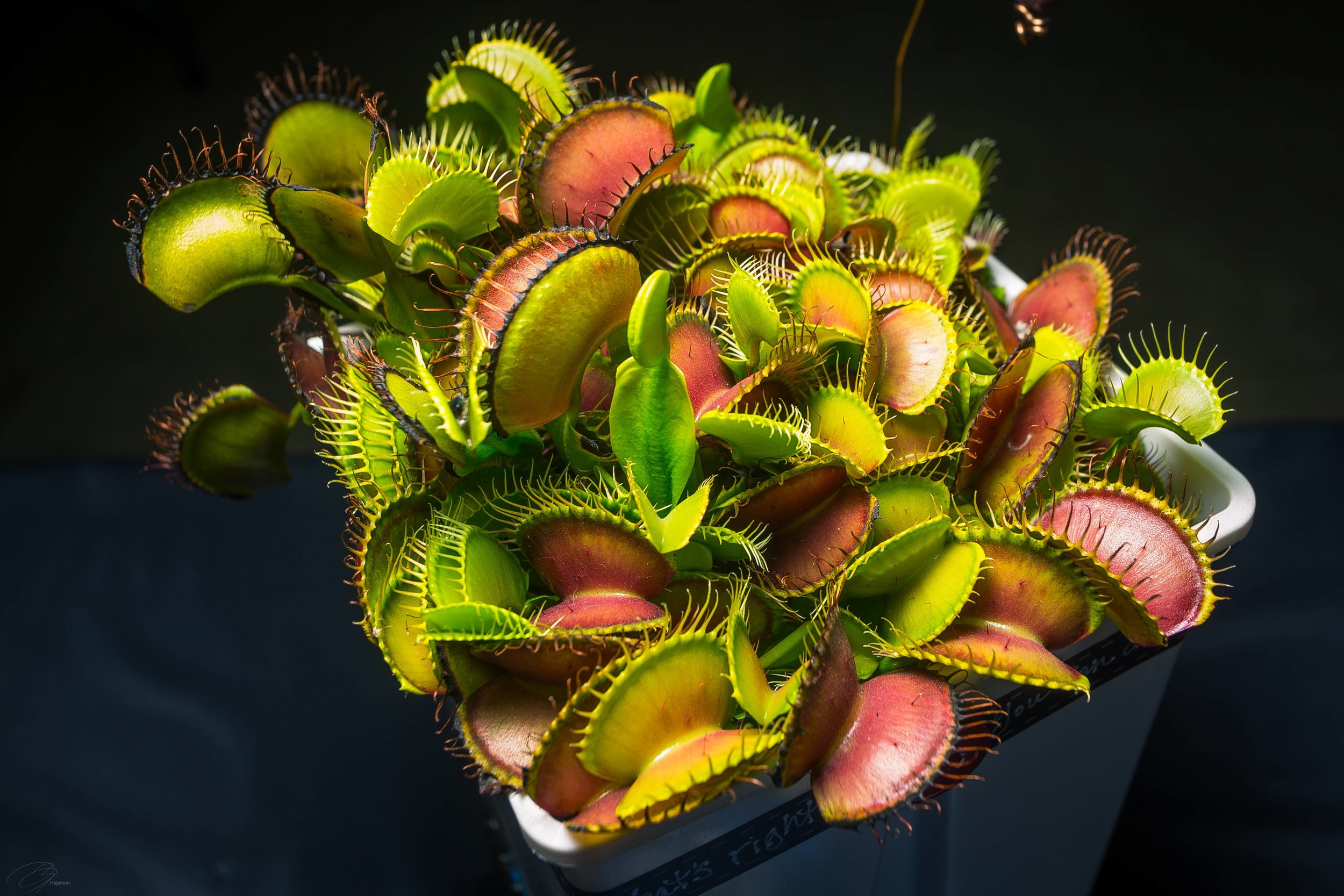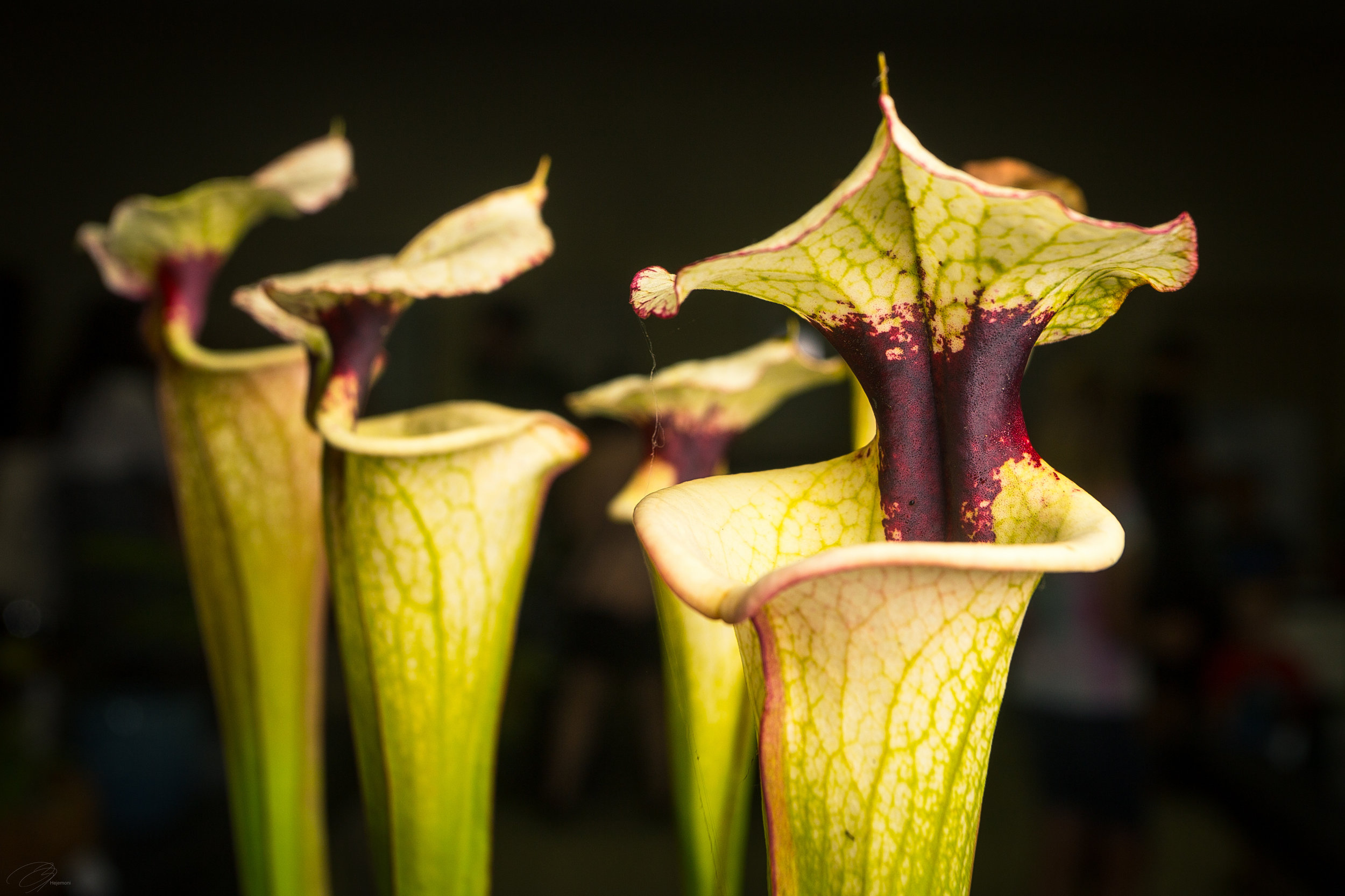A San Diego Growing Guide for Carnivorous Plants
If you live in the coastal or inland valley areas of San Diego County you’ll be able to grow many kinds of carnivorous plants outdoors, year-round, without a greenhouse. Venus flytraps (Dionaea muscipula), North American pitcher plants (Sarracenia), and many sundews (Drosera) thrive in our climate. Some may require protection from our coldest temperatures, but many actually require periods of cold weather.
Our members have also had great outdoor success with some kinds of Asian pitcher plants (Nepenthes), some butterworts (Pinguicula), some bladderworts (Utricularia), cobra lily (Darlingtonia californica), dewy pine (or “Portugese sundew,” Drosophyllum lusitanicum) as well as many other rarer plants.
Growers with indoor spaces have access to a wide range of tropical and subtropical species and hybrids. Plants can be grown in windowsills or under lights to provide ideal levels of brightness. Some growers employ terrariums or grow chambers to fine-tune their conditions further, but many types are good companions to humans and enjoy their living conditions. Many of these enjoy a summer vacation outdoors and only need to be brought inside when temperatures get too chilly.
Carnivorous plants are found around the globe and have different cultural needs. But there’s one basic requirement that will help all of them thrive: good-quality water. The stuff that comes out of San Diego municipal water has way too many minerals to keep these plants happy, so opt instead for distilled water, reverse-osmosis (R/O) water or the free rainwater that falls from the sky.
Also, if the guides below talk about adding peat moss to a soil mix, use a brand that doesn’t contain fertilizers. Premier and Sunshine are locally available brands and are good choices. Miracle-Gro sphagnum peat moss contains fertilizers that may prove fatal to your new plants.
In this quick-start guide we give guide you through to the growing requirements of some of the more common types to help you decide which ones might do well for you!
Venus flytrap. Photograph by Francis Bauzon
Venus Flytraps (Dionaea muscipula)
Probably the classic carnivorous plant, the Venus flytrap is a great choice for outdoor growers in San Diego. Indoors, it’s likely to struggle. In nature the species is only found in bogs in a small coastal region on the North Carolina/South Carolina border where the plants compete with human development. Plants found in the wild tend to have small traps, but growers have selected versions that can get quite large and have traps with different colors and bizarre shapes.
Light: Full sun for half a day or more.
Watering: Keep constantly wet during active growth. Place in shallow trays of standing water that can be allowed to go dry for a day or so. Be sure to use distilled, reverse-osmosis or rain water.
Soil: Use a mixture of 1 part peat moss and 1 part perlite in non-porous pots (plastic or glazed ceramic).
Note that flytraps go dormant around early November and should be grown a little dryer through dormancy. Many people think they’ve killed their plant in late autumn, but chances are excellent that the plant is just resting.
Nepenthes pitcher. Photograph by Francis Bauzon
Asian Pitcher Plants (Nepenthes)
Asian pitcher plants (Nepenthes, or affectionately, “neps”) come from the tropical regions of Southeastern Asia and range as far as northern Australia. Some species are known only from single mountaintops and are at extreme risk from poaching or habitat loss.
Nepenthes is one of several very different groups of plants that are generally called “pitcher plants,” each with its own very specific cultural requirements. Even within Nepenthes, you’ll find lowland tropical plants that require hot and humid sauna conditions to those that prefer the chilly and misty mountaintops thousands of feet up.
Some of the higher-elevation species and many hybrids tolerate or even enjoy the outdoor conditions San Diego offers. Good species to try are Nepenthes sanguinea or N. ventricosa, and the fairly indestructable hybrid N. ventrata. When the weather starts to dip into the low 40s consider moving these indoors or giving them some protection.
Light: Start with strong filtered light. Most will acclimate to full sun earlier or later in the day.
Watering: Keep moist year-round but don’t overwater. Do not stand the plants in trays of water. Be sure to use distilled, reverse-osmosis or rain water.
Soil: Use an open mixture of around 4 parts long-fibered sphagnum moss to 1 part perlite in non-porous pots (plastic or glazed ceramic).
These plants naturally vine or trail in nature, so people often grow them in hanging pots in patios or under trees. During hot, dry periods like when we see our Santa Ana wind conditions, be sure to check in on your plants to be sure they’re not cooking or drying out.
Sarracenia hybrid. Photograph by Francis Bauzon
North American Pitcher Plants (Sarracenia)
The North American pitcher plant, Sarracenia, does very well outdoors in San Diego. (Be sure not to confuse sarracenia with any of the four other plants also called “pitcher plants,” since each has its own very specific cultural needs.) Botanists recognize 8-11 species of Sarracenia, most concentrated in the American South, but some also range up into Canada. Three of the species or varieties are nearly extinct in the wild and are considered federally endangered species.
Breeders produce hundreds of new hybrids every year and you’ll find sarracenia in lots of different sizes, shapes, colors and patterns.
Light: Full sun for half a day or more.
Watering: Keep constantly wet during active growth. Place in shallow trays of standing water that can be allowed to go dry for a day or so. Be sure to use distilled, reverse-osmosis or rain water.
Soil: Use a mixture of 1 part peat moss and 1 part perlite in non-porous pots (plastic or glazed ceramic).
Most of the taller-growing species and hybrids turn brown and go dormant during the winter. The three low-growing species (S. purpurea, S. rosea and S. psittacina) and their hybrids, however, usually stay looking nice throughout the year.
Pinguicula moctezumae. Photograph by James Soe Nyun
Butterworts (Pinguicula)
Butterworts (or “pings” as they’re often called) are characterized by often-broad leaves that trap insects on their sticky sticky surfaces. A big added bonus of butterworts is that they can bloom a lot, and some plants may be in bloom almost constantly. The butterworts that most people grow come from Mexico and thrive indoors in a bright location or under lights.
Once you gain more experience you could try a few of the more tolerant Mexican species or hybrids outdoors. People have had luck particularly with P. gigantea and the hybrid Aphrodite. Protect these guys when the the weather turns cold.
Beyond the Mexican spceicies, several species come from warm temperate regions like the American South and do well outdoors year-round in San Diego. Look for species like Pincuicula lutea, P. caerulea, P. primuliflora and P. planifolia. Don’t worry about protecting these plants from frost.
Light: Start with bright but filtered light.
Watering: Generally grow these moist while in active growth, but dryer than most of the other plants described on this page. Mexican pings like it a little dryer still than their temperate American cousins. Still, none of them should ever dry out. The one exception to this is P. primuliflora, which should be kept wet and can be grown in trays in the shade of larger plants. Be sure to use distilled, reverse-osmosis or rain water.
Soil: For pings, generally use a mix that retains water but doesn’t stay constantly wet. For most of the temperate American species this could be a mix of peat moss, sand and perlite in equal portions. Mexican pings will want a porous mix that’s even dryer, something like an equal mix of quartz sand, peat moss, perlite and fine pumice.
Drosera capensis ‘Albino’, with typical red form below. Photograph by James Soe Nyun
Sundews (Drosera)
Sundews are found almost everywhere on the globe, and many of the species do well outdoors in San Diego. The Cape Sundew (Drosera capensis) is a classic and widely-available beginner plant from South Africa that does great outdoors in full sun or even indoors in a bright location. The thread-leaf sundews (D. tracyi and filiformis, hybrids such as ‘Dreamsicle’) from the American South and East Coast also do great outdoors here, as do the cute rosetted D. spatulata and the spiky D. binata.
Light: Full sun for half a day or more.
Watering: Keep constantly wet during active growth. Place in shallow trays of standing water that can be allowed to go dry for a day or so. Be sure to use distilled, reverse-osmosis or rain water.
Soil: Use a mixture of 1 part peat moss and 1 part perlite in non-porous pots (plastic or glazed ceramic).
Cape Sundews and D. spatulata will tolerate very light frosts. The thread-leaf sundews will tolerate lots of cold after they die back to a little nub in late fall, only to reemerge in the spring with lots of new energy. Some, particularly the Cape Sundew, are prolific bloomers that set lots of dust-like seed. Before you know it you’ll have lots of little plants to share! If you don’t like the seedlings, you can just trim the flower stems before they set seed.
Once you gain experience you’ll find lots of other sundews that you can grow outdoors here.
Cobra lily. Photograph by Francis Bauzon
Cobra Lilies
(Darlingtonia californica)
The charismatic, menacing Darlingtonia (sometimes called “Cobra lily”) has a range that extends northwards from the Sierra Nevada near Lake Tahoe in California into the coastal and coastal mountain areas of northern California and Central Oregon. Along with several other plants in this guide it can be called one of the “pitcher plants.” Although it is distantly related to the North American Pitcher Plants (Sarracenia), it diverged from them about 35 million years ago, and requires different, very specific growing conditions to thrive.
Darlingtonia can be grown outdoors in San Diego, but—fair warning!—most growers find them more difficult than most of the other plants listed here. Still, their crazy unhinged awesomeness makes most people want to give them a try!
Their most specific requirement is that their roots need to be kept cool, in the low 60s at the warmest, even in hot midsummer weather. This comes from the fact that the plants grow in slowly-moving meltwater creeks in the mountains or at the edges of very cool springs closer to the coast. In these locations, the air temperatures may rise quite high, 100 or more, but the water at the roots always stays cool.
Darlingtonia owners get really creative trying to meet their plant’s need for cold roots. Some people grow them in styrofoam coolers, or in light-colored pots, or even slightly open pots that allow for some cooling evaporation. Some people feed them ice cubes, others might even use water-chillers to provide cold water during the hottest months. Some people have little solar fountain setups that keep the water moving through the root zone.
Light: Give them full sun, half a day’s worth or more. Try to keep the roots in shade or in a light-colored pot.
Watering: Keep moist-to-wet year-round. Plan a strategy to provide cool water no warmer than 65 degrees. Standing plants in water works for some, moving water through the pot works better for others. Be sure to use distilled, reverse-osmosis or rain water.
Soil: Some growers have success in a peat/perlite mix as for sarracenia or flytraps, but you might try using a mix that would encourage evaporation around the roots, maybe long-fibered sphagnum moss with a smaller portion of perlite mixed in.
As interest in Darlingtonia increases, some vendors have begun offering plants from warmer locations in the plant’s range. Hopefully some of these will end up being more forgiving of slightly warmer root zone temperatures! And yes, California and Oregon are in North America, but Darlingtonia are generally not the plants referred to when we use the term “North American Pitcher Plant.” “Cobra Lily” works if you want a common name.






